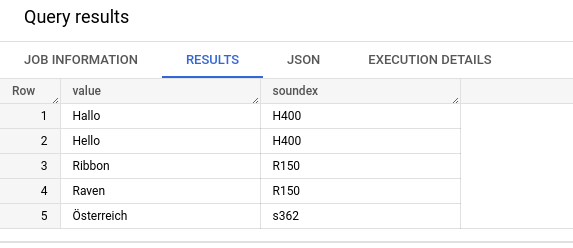Exploring the Soundex Function in Google BigQuery
Written on
Chapter 1: Introduction to Soundex in BigQuery
Have you ever considered the ability to transform text into phonetic sounds within BigQuery for large-scale data analyses? The SOUNDEX function is designed to create a phonetic representation of strings, indexing words based on their pronunciation in English. This function is particularly useful for identifying strings that sound alike, such as the surnames Levine and Lavine, or the words to and too.
The Soundex code format comprises one letter followed by three digits. If the word contains more letters than can be represented by three digits, the encoding stops at the third digit. Conversely, if there are fewer letters, the remaining digits are filled with zeros. For instance, the name Lee is represented as L-000.
The letter codes are as follows:
- B, F, P, V
- C, G, J, K, Q, S, X, Z
- D, T
- L
- M, N
- R
Vowels (A, E, I, O, U) and the consonants (H, W, Y) are disregarded, except for the initial character. Additionally, German umlauts such as Ä, Ö, and Ü are ignored, while the sharp S (ß) is treated as an S.
Here’s a simple example to illustrate its application:
WITH example AS (
SELECT 'Hallo' AS value UNION ALL
SELECT 'Hello' AS value UNION ALL
SELECT 'Ribbon' AS value UNION ALL
SELECT 'Raven' AS value UNION ALL
SELECT 'Österreich' AS value
)
SELECT value, SOUNDEX(value) AS soundex
FROM example;

Chapter 2: Applications of the Soundex Function
The Soundex function serves as a valuable tool for examining the pronunciation of words within the realm of Big Data. Its relevance extends beyond linguistics; it can also be beneficial in analyzing social media data, where spoken content is frequently shared on platforms like Twitter. Furthermore, this function can be instrumental in data cleaning, enabling the detection of errors in text generated from speech.
Although the applications might appear limited, the potential of the Soundex function is indeed fascinating.
Other related functions and updates in BigQuery that you may find intriguing include:
- Using the Split Function in BigQuery
- Working with Strings in Google BigQuery
- Google’s Integration of BigQuery with Apache Spark
- Utilizing the Farm Fingerprint Function in BigQuery for Data Hashing
Sources and Further Readings
[1] Google, SOUNDEX (2022)
[2] Wikipedia, Soundex (2022)